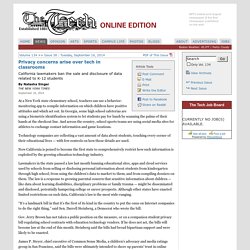

What Do Schools Risk By Going ‘Full Google’? Kaitlin Morgan says, this year, her school district is going “full Google.”

Morgan teaches U.S. and world history and advises the yearbook at Woodlake Union High School in California’s Central Valley. At Woodlake, “full Google” means a plan to have one Google Chromebook for every two students by the spring, running Google Apps. The Chromebook is a relatively cheap, stripped-down laptop. It’s become popular in the education world, with 85 percent of its U.S. sales last year going to the ed market. And the Chromebook is just the beginning. It’s the beginning of what Google calls the “paperless classroom” — moving assignments, class discussions, feedback, tests and quizzes online. Now comes Google’s latest education offering, launched last week: Google Classroom.
Classroom enables a teacher to create a “class” at the touch of a button. Teachers see instantly who has turned in their homework. Privacy concerns arise over tech in classrooms. Privacy concerns arise over tech in classrooms California lawmakers ban the sale and disclosure of data related to K-12 students September 16, 2014 At a New York state elementary school, teachers can use a behavior-monitoring app to compile information on which children have positive attitudes and which act out.

In Georgia, some high school cafeterias are using a biometric identification system to let students pay for lunch by scanning the palms of their hands at the checkout line. And across the country, school sports teams are using social media sites for athletes to exchange contact information and game locations. Learning Analytics – Ethical questions and dilemmas. Code of Technology Ethics for Educators. Code of Technology Ethics for Educators Since technology and computers have become an important part of our daily lives, it is equally important that technology be fused into the education process.

Not only must educators exhibit ethical excellence in how technology is used in their profession, but educators must instill the same standards in their students. This Code will serve to guide educators in achieving ethical conduct while using computers in education. This document will provide educators with standards of conduct that govern their relationship with technology and their obligation to the communities they serve. I. Standard 1. Rationale: Educators strive to help students acquire, practice, and use new information in the best possible learning environments and with the best possible set of tools.
Standard 2. Rationale: The field of Education, takes its direction for instructional practices, including the use of technology, from national, state, and district guidelines. II. III. V. Position Paper %233. The Ethics of EdTech. Actu | Innovation Céline Authemayou, Translated by Nina Fink | Publié le.

"Edtech and Student Privacy: California Law as a Model" by Dylan Peterson. Innover pour une école à la fois plus juste et plus efficace. Deux rapports vont être rendus publics prochainement sur le thème de l’innovation.

L’un a été confié au chercheur François Taddéi, à qui on a demandé de réfléchir à la recherche-développement en éducation dans l’enseignement scolaire et supérieur. L’autre est l’émanation des travaux du Conseil national de l’innovation pour la réussite éducative, une instance créée en 2013 et que je préside depuis septembre 2016. Ce sera le 3e et ultime rapport qui sera rendu public lors de la journée de l’innovation qui se tient le 29 mars. Utiliser les formulaires de l ENT. Log In - New York Times. Logiciel libre. Un article de Wikipédia, l'encyclopédie libre.

Logo du projet GNU, initiateur du mouvement du logiciel libre. Un logiciel libre est un logiciel dont l'utilisation, l'étude, la modification et la duplication en vue de sa diffusion sont permises, techniquement et légalement[1]. Framabook – Le pari du livre libre. Framasoft ~ Page portail du réseau. Evaluating the Privacy and Security of Ed Tech.
IT Best Practices Evaluating the Privacy and Security of Ed Tech 7 Questions to Guide the Process By Bill Fitzgerald When working with educational technology, responsible decision makers in schools recognize the need for solid security and privacy practice in software applications.

However, defining an acceptable level of privacy protection, or an adequate level of security, can feel imprecise. As we navigate evaluating the privacy and security protections of educational software, the following questions and observations can help guide the process. Bill Fitzgerald. State of EdTech. Privacy - Office of Educational Technology. Privacy Technical Assistance Center (PTAC) The U.S. Department of Education is committed to both technological progress and the protection of privacy and security for students, educators, and all involved in schools. The U.S. Department of Education runs the Privacy Technical Assistance Center (PTAC) as a “one-stop” resource for answering questions and addressing concerns related to privacy, confidentiality, and security practices.
Education Technology and Data Insecurity. 18 min read This is part eight of my annual review of the year in ed-tech Pokémon Go, a free augmented reality game developed by Niantic (a company spun out of Google in 2015), became the most popular mobile game in US history this year.

The game was launched in July and despite mixed reviews, was downloaded some 10 million times the first week it was released. Pokémon Go generated more than $160 million by the end of July, hitting $600 million in revenue within its first 90 days on the market – the fastest mobile game to do so. Always eager to associate itself with the latest tech craze, education technology embraced Pokémon Go with great gusto: “Why Pokemon Go shows the future of learning gamification.” Préserver les données personnelles des élèves Avec l’utilisation croissante du numérique par le monde éducatif, l’établissement ou les enseignants sont parfois amenés à collecter et à publier via les réseaux informatiques des données personnelles concernant les élèves.

Ces données peuvent permettre une identification directe ou indirecte de l’élève et cette diffusion peut lui être préjudiciable. Avant d’entreprendre une quelconque publication des travaux des élèves, ou d’un « trombinoscope » par exemple, il faut prendre connaissance de quelques règles et usages.